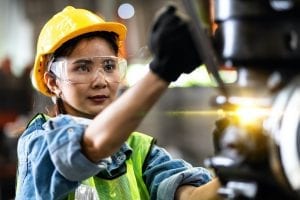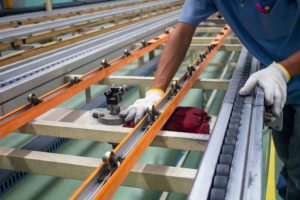How Technology Can Help CPG Companies Facing Record Demand
As communities around the world respond to concerns over the coronavirus (COVID-19) pandemic, CPG manufacturers face unique challenges. Particularly, what people buy, where they shop and how often have drastically changed. The sense of predictability in relation to shopping patterns has reduced, which adds another level to the complexity of manufacturing.
The uncertainty around the pandemic has caused people to stock up – even hoard – unexpectedly on pantry and household staples and cleaning supplies. As a result, consumer product companies in certain categories are now under immense pressure and operational stress. Many CPG brands are ramping up production lines to meet the growing consumer demand, especially in the food, beverage and consumer hygiene products industries.
What Experts Are Saying
Geoff Freeman, president and CEO of the Consumer Brands Association (CBA), says the industry is used to increased demand around specific events or points in time such as Thanksgiving or the Super Bowl. However, in recent weeks it has been greater than any one holiday or sporting event. Freeman said members have seen an increase in orders by as much as 700% as consumers stock up and shelter in place.
For a useful perspective in terms of the scale of the worker impact of the U.S. CPG industry, a recent study by a coalition of 21 food and beverage industry groups, including the CBA, found that the wider industry, from farms to factories to grocery stores is responsible for roughly 47 million jobs, $2.27 trillion in wages and $885.29 billion in taxes.
It’s an unprecedented and enormously complicated time we live in. On one hand, people are being told to stay home except for essential needs. On the other hand, production continues and has even increased for many CPG manufacturers. The spike in consumer demand has necessitated that people who work in the CPG industry – whether they’re on the shop floor in a factory or working at some point along the supply chain – go to their jobs. These are our unsung heroes, along with healthcare workers, who play a critical role in the healthy functioning and survival of our society.
How can CPG brands keep up with the growing consumer demand while ensuring the health and safety of their own employees?
Analysts covering the manufacturing and industrial space are seeing how connected worker technology can play a role. According to Gartner analyst Simon Jacobson in a March 17 article, “Today, tribal knowledge is still a constraint to reliable output from shift to shift or site to site…capturing this tacit and institutional knowledge is priceless insight and can be a jumping-off point for new cross-training and skills certifications, along with scalable improvements.”
And according to analyst Peter Bussey at LNS Research, “Another potential area of innovation and investment [related to COVID-19] are Connected Worker technologies such as mobile devices, wearables, augmented reality, proximity beacons, location tracking, etc. Such technologies are being increasingly incorporated into [industrial transformation] programs to improve productivity, quality, and safety performance.”
Worker Safety is Paramount
While it’s important to ensure you’re meeting the needs of your customers, the health and wellbeing of your team is paramount. Humans are your most valuable asset, which we appreciate now more than ever. Adapting to our new situation means that shift handovers and collaboration now have to accommodate social distancing and reduced physical contact on the production floor.
With some manufacturing facilities operating at maximum capacity, it’s extremely important to ensure consistent safe work practices across the board. In the best of times, human error accounts for many work safety incidents, from incorrectly operating a machine to not following a protocol – which can have disastrous effects. Add a global pandemic into the mix, and the complexity just escalated enormously.
Connected worker technologies, such as those referenced by LNS Research, can help mitigate risks by integrating safety checks within the work execution itself.
It can trigger reminders and procedures by assessing the safety characteristics of each task or job. This is done through digitized, in-line procedural information, which helps to ensure adherence – be it reminding workers to wear a hard hat or mask when operating in certain parts of the plant, or making a final equipment checklist. Reminders and guides to safe hygiene practices can be built into the workflows to ensure compliance and enable monitoring.
Managers have even more visibility into work being performed on the factory floor at all times. This helps to ensure your teams are executing work safely, correctly and on time — no matter where they are, and in the moment. Full traceability puts all the information about a particular product batch at your fingertips. By gaining access to granular data every step of the way, you’re able to recognize potential deviations from your quality and safety procedures. Dashboards provide insights to help identify outliers and trends over time.
Resources That Can Help Overcome the Growing Demand
As CPG manufacturers ramp up production, not only do they need to adhere to production schedules but it’s also important to focus on compliance. For example, how do you make a run more efficient? If there’s an issue on the operating line and something may not be up to spec, that results in waste. That loss could’ve been avoided if standard operating procedures (SOPs) were followed correctly.
With connected worker software, your team has access to step-by-step digital SOPs on how to complete each of their actions effectively and safely. If a frontline worker runs into an issue on the production line, they can receive an alert and follow guided instructions on how to safely address the situation. They can also notify the appropriate teams immediately for expert advice via call, text or video, so the issue is identified and resolved before the product is already down the line.
Another important aspect to consider, as certain manufacturers are full steam ahead, is autonomous maintenance. If we assume machines are running at capacity, it’s important to understand what problems could potentially affect production and how you can proactively mitigate such issues from arising. Rather than running the machines until they break or become due for maintenance and then hand them to the maintenance department, autonomous maintenance can be carried out by machine operators. It allows individuals on the operating line to perform checks, taking specific actions so that the machine is in a state where it can successfully run. Line workers can complete clean/inspect/lubricate (CIL) maintenance, by cleaning, inspecting for any potential problems (for example, damage, faulty parts, wear and tear) and lubricating the machine.
With connected worker technology, a line worker can open a CIL job on a mobile device and follow clear instructions that contain interactive rich-media – inline videos, photos, GIFs and PDFs – on how to complete the task correctly. If an operator is performing a routine CIL inspection, they can log details of an equipment issue into the app and immediately share the information with a line leader or maintenance personnel. Not only does the supervisor have a real-time view into what is happening, but they are able to provide a response to triage the issue.
Our world is drastically different today from just a month ago. As certain CPG manufacturers are faced with increasing pressure to keep up with growing consumer demand, there are a number of ways modern technology can help them ramp up production speed, scale effectively, and handle complexity. Please see this letter from our CEO, Lawrence Whittle, to read more specifics about Parsable and COVID-19.







